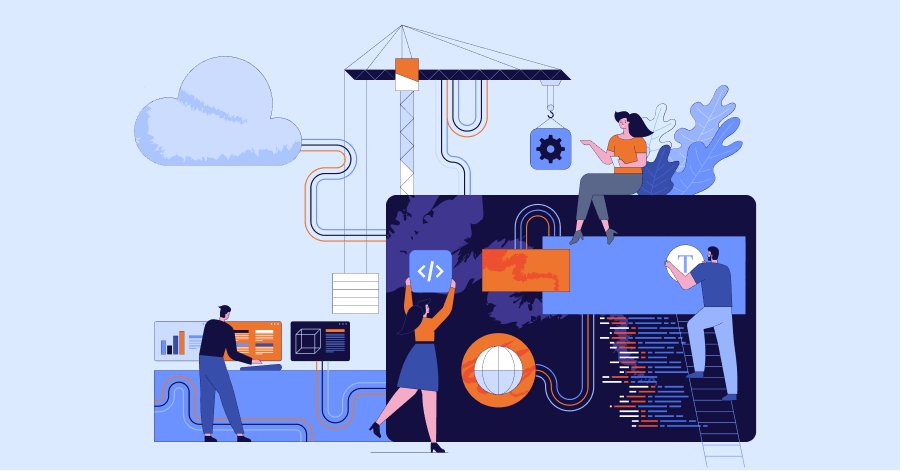Entrepreneurs are often surprised at the diversity of software engineering, particularly in the types and roles of these tech experts. You’ll come across front-end and back-end developers, data scientists, full-stack engineers, DevOps engineers, security specialists, and more. So, who do you need to build your software product?
This guide explains what your ideal software development team structure should look like to create your MVP.
Qualities of A Good Software Team Structure
Software development is a highly collaborative process lasting several weeks, months, or years. You want the best possible team of experts that fits your business and budget. With numerous software outsourcing services available today, consider these top four qualities as you search for your ideal software team:
1. Excellent Communication
The team must communicate the impacts of each request and weigh its suitability for inclusion in an MVP. Just saying “yes” to all requests can result in an over-inflated and an over-budget MVP. Look for a team that communicates clearly and offers constructive criticism of your app or solution. This way, you’ll find the right course of action that combines your ideas with the developers’ experience.
2. Proven Expertise
There is a lot more to software development than just proficiency in writing code. Choose a team with years of experience in the software domain you need, whether app design, e-commerce, machine learning, data analytics, cybersecurity, etc.
3. Portfolio
An experienced software development team has a good portfolio of successful projects that you can study. Interact with their previous clients’ apps, read their case studies, and ask for references.
4. Pricing
A custom software project often costs more than entrepreneurs expect because of the complete team structure. The more experts needed for your project, the higher your project cost would be.
Six Essential Roles in A Software Team Structure
You need the following roles on the team for your software development project:
- A Product Owner (PO)
- A Project Manager (PM)
- A Business Analyst (BA)
- A UI/UX Designer
- A Senior Software Engineer
- A Quality Assurance (QA) Engineer
These team members can get your application from concept to testing and implementation, even if you have no in-house IT talent or a limited budget. Here’s how each role contributes to your software development process.
1. Product Owner (PO)
In most cases, a Product Owner (PO) is actually the entrepreneur who carries the solution’s vision and business goals. You don’t need technical knowledge to be a PO, but you can delegate the role to someone more suitable to communicate your vision. A Product Owner engages with all the software team specialists to share their ideas and answer the team’s questions.
One essential task for a PO is to create a list of features you want in the solution, called the product backlog. This document guides the software development stages and must be as detailed as possible.
The role of a product owner is to set expectations, define the project’s direction and milestones, and offer guidance when challenges arise. Therefore, the PO is a software development team member that ensures the MVP process meets business objectives.
2. Project Manager (PM)
Every software development team structure needs a project manager (PM) to manage the team’s activities, budget and schedules. Without oversight, your MVP will likely miss deadlines, go over budget, and ultimately fail. The PM ensures the complete MVP process flows efficiently and satisfies all stakeholders.
Ideally, a PM should have a software development background to estimate tasks, schedules, and budget needs. The PM and PO work closely to understand and communicate your MVP concept, end-user experience, and target market.
Pro tip: You may have the software development knowledge to begin an MVP. However, if you plan to scale your project, include a qualified Project Manager in your team.
3. Business Analyst (BA)
A Business Analyst (BA) knows how to use data to inform business decisions, whether you’re looking to launch a new app for an existing company or only have an idea to start with. A BA’s primary role is to reduce risk: they study the competitive landscape, understand end-user pain points, and offer data insights to increase your product’s chances of success.
Some entrepreneurs choose a BA with general market research and analysis skills as a cost-effective option. Unfortunately, you may expose yourself to risk if this analyst has no previous experience with technology start-ups or MVP development. A qualified business analyst is an invaluable asset to your software team structure; otherwise, you create a product that users don’t want, need, or like.
Pro tip: It’s helpful to have a Technical Business Analyst on an MVP team as they would be better able to bridge any unintended gaps between the PO and the technical team, especially in circumstances where the PO is not technically oriented.
4. UI/UX Designer
Also called a software designer (SD), a UI/UX designer creates the look and feel of the app that users love. A beautiful, intuitive app design can tremendously boost your conversion rate by up to 400%, so having a talented designer in your software development team structure is worth it. An experienced designer understands how to balance code with aesthetics rather than falling back on app templates that lose value and engagement over time.
Have a UI/UX designer on your software team structure right from the start. Their contribution to your MVP begins from the discovery stage to improve the concept to A/B testing your solution and building a unique brand identity. Choose a software designer who can create a user-friendly and seamless app interface that your target users rely on.
5. Senior Software Engineer/Developer/Programmer
A software engineer builds a solution that responds to your end user’s queries, connects to other apps, and meets your stakeholders’ expectations. There are three main kinds of software developers:
- A front-end developer uses HTML, CSS, JavaScript, or other programming languages to build your software’s user interface.
- A back-end developer uses PHP, Python, Ruby, and other tools to connect your software to databases, servers, and other apps to keep your solution online and functional.
- A mobile developer uses Flutter, Kotlin, React Native, or other app development frameworks to make your solution available on iOS and Android app stores.
Pro tip: If you’re uncertain about these software engineering roles, including a software architect or technical lead in your team structure is helpful. A software architect is highly skilled in coding, technical designs and architecture. This expert can bridge the gap between your MVP concept, business goals, and software specialists.

6. Quality Assurance Engineer (QA)
A Quality Assurance Engineer must not be overlooked as their expertise lies in finding errors or bugs in your software product, which otherwise your users will find.
You might want to do the testing yourself as the project owner or assign the role to your software engineer. However, you’ll quickly discover that you have other business tasks that need your attention, and your developer has their hands full with writing and fixing code. A QA engineer dedicates their time to testing and validating your MVP’s functionality, saving resources you may otherwise lose.
Pro tip: Software engineers who deploy, support, and monitor an application are generally known as DevOps engineers (development and operations). You can have a DevOps expert during the initial MVP process, then choose specialists as you scale.
Factors That Determine Your Software Team Size
A software development team structure may comprise five to nine people generally, per team. The roles described above are ideal for the initial MVP process, but remember that with a good product comes a great demand to scale. You’ll add more members to your software team structure, but how big should you get? Consider the following factors:
1. Complexity
Four to six software specialists are good for building an MVP, but more app features and upgrades will need more experts on the team. You may also encounter new challenges during and after launching your MVP, requiring specific consultants to troubleshoot and resolve issues.
2. Time to market
Consider how quickly you need to get your product to your users. A smaller team can deliver your needs if your schedule is more flexible. But a larger group will get you to market faster if your deadlines are tighter due to competition or market demand.
3. Budget
You may have an MVP idea but no business yet, so the amount of capital you can put into a software team structure will restrict the experts you will have. You may also have an established business, but other operational factors limit your IT budget. In each case, start with a small team and add members over time, rather than having a large group and running out of budget.
4. Platform
Suppose you’re focusing on a mobile-only application. In that case, your software development team structure may have five to six experts for iOS and Android development. However, if your solution runs on desktop and mobile, you’ll need experts specializing in various operating systems and browsers and further resources spent on quality control.
Types of Software Development Team Structures
Another factor to consider when planning your software development project is the various team structures you can assemble for your project, such as:
- A generalist software development team: If your project has low to medium complexity, you can choose a team with a broad knowledge of software development. This way, a developer combining front-end, back-end, and UI/UX design can start the MVP process with your project manager.
- A specialist software development team: If your MVP is more complex or needs deep expertise in a particular tech field, work with a group of specialists. These experts have extended knowledge in a specific programming language, platform, or technology.
- A hybrid software development team: If your MVP scope is broad and needs to scale over time, combine generalist developers with experts to maximize your efficiency. This way, developers with vast knowledge team up with subject matter experts during development.
Pro tip: Each software development team structure has pros and cons. For example, a generalist team may have limited skill sets, meaning you’ll need a specialist to join the group. At the same time, a hybrid team takes time to assemble, while a specialist team can be expensive and need better workflow coordination. Choose the best team structure for your budget, schedule, and business objectives.
How To Match Your Software Team Structure To Your Project Phases
The five stages of software development are analysis, design, development, testing, and implementation. Each phase requires specific software experts, as explained below:
- Analysis phase: You need the Project Owner, Business Analyst, and Project Manager to set the proper foundation for your software development project.
- Design phase: Include your UI/UX designer in the analysis team to visualize the features and performance you need from your software.
- Development phase: This is where your Software Engineers join the team (front-end, back-end, and DevOps) to do the actual coding and bring your software to life.
- Testing phase: Your Quality Assurance engineer works to find and fix critical issues with your software before going to market. Any issues found will more than likely engage the Software Engineers to fix.
- Implementation phase: At this point, your full team prepares to respond to user feedback after launching your MVP; they also adapt and upgrade the software based on this feedback.
Pro tip: If you adopt the agile methodology for your MVP, remember that the development phases above become a cycle, gathering feedback to inform further app iterations. Agile also requires a team size of between three and nine members, meaning a hybrid team structure may work best for your project.
Set Up The Ideal Custom Software Team Structure With Sphere Partners
At Sphere Partners, we support businesses throughout the entire software development lifecycle. You may have an app idea you wish to test or want to take advantage of startup investment funding opportunities. You may already have an app in the market that needs further development.
Whichever your scenario, Sphere Partners can set up the ideal software development team structure for you to meet your business objectives. Our custom software development services bring together a team of experts to match your use case. Reach out to us for advice on getting the best fit software development team structure for your project.




